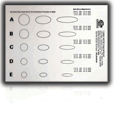We need your consent to use the individual data so that you can see information about your interests, among other things. Click "OK" to give your consent.
ASTM E930-18
Standard Test Methods for Estimating the Largest Grain Observed in a Metallographic Section (ALA Grain Size)
Translate name
STANDARD published on 1.12.2018
The information about the standard:
Designation standards: ASTM E930-18
Publication date standards: 1.12.2018
SKU: NS-936581
The number of pages: 6
Approximate weight : 18 g (0.04 lbs)
Country: American technical standard
Category: Technical standards ASTM
The category - similar standards:
Annotation of standard text ASTM E930-18 :
Keywords:
ALA grain, caliper diameter, comparison procedure, ellipse measurement, grain size, largest grain, measuring procedure, metallography, microstructure, outlier grain, point-count procedure,, ICS Number Code 19.120 (Particle size analysis. Sieving)
These adjuncts apply to this standard:
Adjunct to E930 Test Methods for Estimating the Largest Grain Observed in a Metallographic Section (ALA Grain Size)
Selected format:Show all technical information.
Additional information
| Significance and Use | ||||||||||||
|
4.1 The presence of large grains has been correlated with anomalous mechanical behavior in, for example, crack initiation, crack propagation, and fatigue. Thus there is engineering justification for reporting the ALA grain size. 4.2 These methods shall only be used with the presence of outlier coarse grains, 3 or more ASTM grain size numbers larger than the rest of the microstructure and comprising 5 % or less of the specimen area. A typical example is shown in Annex A1 as Fig. A1.1. 4.3 These methods shall not be used for the determination of average grain size, which is treated in Test Methods E112. Examples of microstructures that do not qualify for ALA treatment are shown in Annex A1 as Fig. A1.2, Fig. A1.3, and Fig. A1.4. 4.4 These methods may be applied in the characterization of duplex grain sizes, as instructed in the procedures for Test Methods E1181. |
||||||||||||
| 1. Scope | ||||||||||||
|
1.1 These test methods describe simple manual procedures for measuring the size of the largest grain cross-section observed on a metallographically prepared plane section. 1.2 These test methods shall only be valid for microstructures containing outlier coarse grains, where their population is too sparse for grain size determination by Test Methods E112. 1.3 This standard does not purport to address all of the safety concerns, if any, associated with its use. It is the responsibility of the user of this standard to establish appropriate safety, health, and environmental practices and determine the applicability of regulatory limitations prior to use. 1.4 This international standard was developed in accordance with internationally recognized principles on standardization established in the Decision on Principles for the Development of International Standards, Guides and Recommendations issued by the World Trade Organization Technical Barriers to Trade (TBT) Committee. |
||||||||||||
| 2. Referenced Documents | ||||||||||||
|
We recommend:
Technical standards updating
Do you want to make sure you use only the valid technical standards?
We can offer you a solution which will provide you a monthly overview concerning the updating of standards which you use.
Would you like to know more? Look at this page.





 Cookies
Cookies
